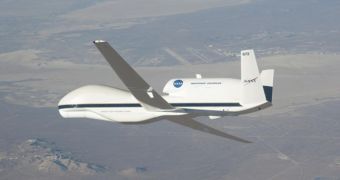The American space agency is about to begin a new chapter in its Earth exploration science program, as it prepares to fly an unmanned aerial vehicle (UAV) for the first time. The Global Hawk flight system was originally developed for reconnaissance and combat purposes, but engineers at NASA managed to convert one into a multi-purpose science platform that will be able to provide them with advanced readings of the planet's atmosphere. The first flights are less than a few weeks away, they say.
The remote-controlled airplane can fly at very high altitudes and over considerable distances. It can remain airborne in excess of 24 hours, which is a considerable progress from the science conducted from aircrafts until now. Generally, large, manned planes cannot remain in the air for so long without refueling, and pilots need their rest as well, in order to maintain a high level of performance. But these issues are eliminated with the Global Hawk, whose controllers can change shift seamlessly, TechNewsDaily reports.
“It's a very exciting time, This is the very first time that Global Hawk will be used for science,” explains Global Hawk project manager Chris Naftel. The space agency currently owns two Global Hawk UAV, which were first built and delivered several years ago, but were originally meant to be surveillance units. Now, NASA is retrofitting them with a wide array of scientific equipment, from high-definition cameras to ozone sensors. If the flights are a success, then an additional UAV may be converted for scientific duties as well.
The thing about the Global Hawk is that it can fly at altitudes of about 65,000 feet, while remaining airborne for about 30 hours. The aircraft has the ability to carry about 2,000 pounds, or 907 kilograms, of payload, which may consist of weaponry, scientific equipment or surveillance cameras. It features a wingspan of no less than 116 feet, or 35 meters, and a length of about 44 feet (13 meters). Engineers at the Edwards Air Force Base (EAFB) and the NASA Dryden Flight Research Center – which is located at the airfield – have been working continuously to install and test all the complex measuring devices that will eventually make their way on the Global Hawk.

 14 DAY TRIAL //
14 DAY TRIAL //